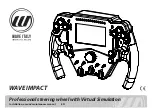
6.1 General
93
|
www.lakeshore.com
Chapter 6: Computer Interface
Operation
6.1 General
This chapter provides operational instructions for the computer interface for the
Lake Shore Model 336 temperature controller. Each of the three computer interfaces
provided with the Model 336 permit remote operation. The first is the IEEE–488
interface described in section 6.2. The second is the USB interface described in
section 6.3. The third is the Ethernet interface described in section 6.4. The three
interfaces share a common set of commands detailed in section 6.6. Only one of the
interfaces can be used at a time.
6.2 IEEE-488
Interface
The IEEE–488 interface is an instrumentation bus with hardware and programming
standards that simplify instrument interfacing. The Model 336 IEEE–488 interface
complies with the IEEE-488.2 standard and incorporates its functional, electrical,
and mechanical specifications unless otherwise specified in this manual.
All instruments on the interface bus perform one or more of the interface functions of
Talker, Listener, or Bus Controller. A Talker transmits data onto the bus to other
devices. A Listener receives data from other devices through the bus. The Bus Control-
ler designates to the devices on the bus which function to perform. The Model 336
performs the functions of Talker and Listener, but it cannot be a Bus Controller. The
Bus Controller is the digital computer that tells the Model 336 which functions to
perform.
TABLE 6-1 defines the IEEE–488 capabilities and subsets for the Model 336:
Instruments are connected to the IEEE–488 bus by a 24-conductor connector cable
as specified by the standard (section 8.10.1). Cables can be ordered from Lake Shore
as IEEE-488 Cable Kit 4005, or they can be purchased from other electronic suppliers.
Cable lengths are limited to 2 m (6.6 ft) for each device and 20 m (65.6 ft) for the
entire bus. The Model 336 can drive a bus with up to ten loads. If more instruments or
cable length is required, a bus expander must be used.
Subset
Capabilities
SH1:
Source handshake capability
RL1:
Complete remote/local capability
DC1:
Full device clear capability
DT0:
No device trigger capability
C0:
No system controller capability
T5:
Basic Talker, serial poll capability, talk only,
unaddressed to talk if addressed to listen
L4:
Basic Listener, unaddressed to listen if
addressed to talk
SR1:
Service request capability
AH1:
Acceptor handshake capability
PP0:
No parallel poll capability
E1:
Open collector electronics
TABLE 6-1
Model 336 IEEE-488 interface capabilities
and their subsets
Summary of Contents for 336
Page 4: ...Model 336 Temperature Controller...
Page 6: ...Model 336 Temperature Controller...
Page 26: ...14 cHAPTER 1 Introduction Model 336 Temperature Controller...
Page 54: ...42 cHAPTER 3 Installation Model 336 Temperature Controller...
Page 84: ...72 cHAPTER 4 Operation Model 336 Temperature Controller...
Page 104: ...92 cHAPTER 5 Advanced Operation Model 336 Temperature Controller...
Page 164: ...152 cHAPTER 7 Options and Accessories Model 336 Temperature Controller...
Page 178: ...166 cHAPTER 8 Service Model 336 Temperature Controller...
















































